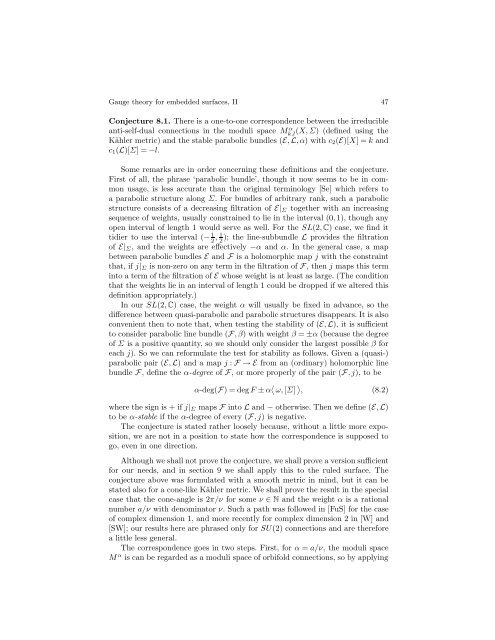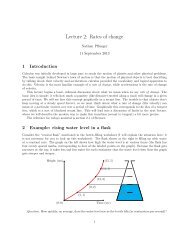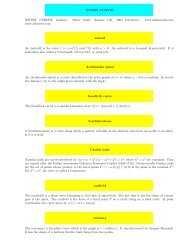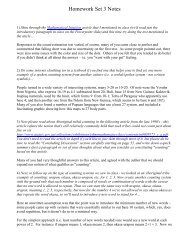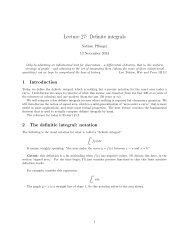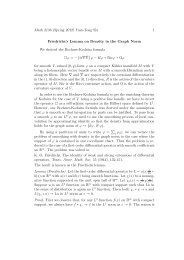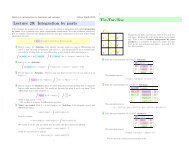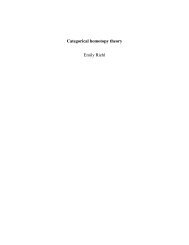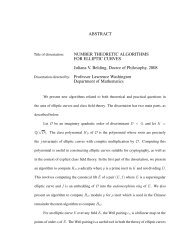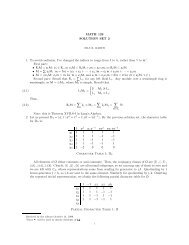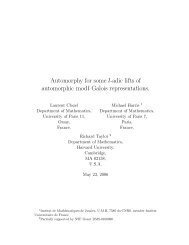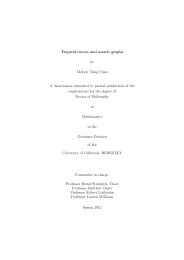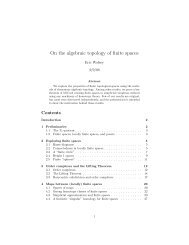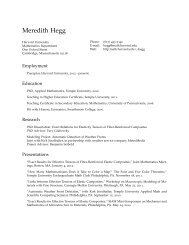Gauge theory for embedded surfaces, II
Gauge theory for embedded surfaces, II
Gauge theory for embedded surfaces, II
Create successful ePaper yourself
Turn your PDF publications into a flip-book with our unique Google optimized e-Paper software.
<strong>Gauge</strong> <strong>theory</strong> <strong>for</strong> <strong>embedded</strong> <strong>surfaces</strong>, <strong>II</strong> 47<br />
Conjecture 8.1. There is a one-to-one correspondence between the irreducible<br />
anti-self-dual connections in the moduli space M α k,l (X,Σ) (defined using the<br />
Kähler metric) and the stable parabolic bundles (E, L,α)withc2(E)[X]=kand<br />
c1(L)[Σ]=−l.<br />
Some remarks are in order concerning these definitions and the conjecture.<br />
First of all, the phrase ‘parabolic bundle’, though it now seems to be in common<br />
usage, is less accurate than the original terminology [Se] which refers to<br />
a parabolic structure along Σ. For bundles of arbitrary rank, such a parabolic<br />
structure consists of a decreasing filtration of E|Σ together with an increasing<br />
sequence of weights, usually constrained to lie in the interval (0, 1), though any<br />
open interval of length 1 would serve as well. For the SL(2, C) case, we find it<br />
tidier to use the interval (− 1<br />
1<br />
2 , 2<br />
); the line-subbundle L provides the filtration<br />
of E|Σ, and the weights are effectively −α and α. In the general case, a map<br />
between parabolic bundles E and F is a holomorphic map j with the constraint<br />
that, if j|Σ is non-zero on any term in the filtration of F, thenjmaps this term<br />
into a term of the filtration of E whose weight is at least as large. (The condition<br />
that the weights lie in an interval of length 1 could be dropped if we altered this<br />
definition appropriately.)<br />
In our SL(2, C) case, the weight α will usually be fixed in advance, so the<br />
difference between quasi-parabolic and parabolic structures disappears. It is also<br />
convenient then to note that, when testing the stability of (E, L), it is sufficient<br />
to consider parabolic line bundle (F,β)withweightβ=±α(because the degree<br />
of Σ is a positive quantity, so we should only consider the largest possible β <strong>for</strong><br />
each j). So we can re<strong>for</strong>mulate the test <strong>for</strong> stability as follows. Given a (quasi-)<br />
parabolic pair (E, L) andamapj:F→Efrom an (ordinary) holomorphic line<br />
bundle F, define the α-degree of F, or more properly of the pair (F,j), to be<br />
α-deg(F)=degF±α ω,[Σ] , (8.2)<br />
where the sign is + if j|Σ maps F into L and − otherwise. Then we define (E, L)<br />
to be α-stable if the α-degree of every (F,j) is negative.<br />
The conjecture is stated rather loosely because, without a little more exposition,<br />
we are not in a position to state how the correspondence is supposed to<br />
go, even in one direction.<br />
Although we shall not prove the conjecture, we shall prove a version sufficient<br />
<strong>for</strong> our needs, and in section 9 we shall apply this to the ruled surface. The<br />
conjecture above was <strong>for</strong>mulated with a smooth metric in mind, but it can be<br />
stated also <strong>for</strong> a cone-like Kähler metric. We shall prove the result in the special<br />
case that the cone-angle is 2π/ν <strong>for</strong> some ν ∈ N and the weight α is a rational<br />
number a/ν with denominator ν. Such a path was followed in [FuS] <strong>for</strong> the case<br />
of complex dimension 1, and more recently <strong>for</strong> complex dimension 2 in [W] and<br />
[SW]; our results here are phrased only <strong>for</strong> SU(2) connections and are there<strong>for</strong>e<br />
a little less general.<br />
The correspondence goes in two steps. First, <strong>for</strong> α = a/ν, the moduli space<br />
M α is can be regarded as a moduli space of orbifold connections, so by applying


